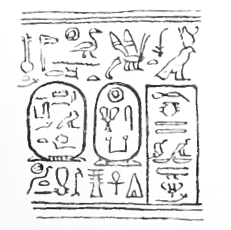Attestations
As a king of the early 13th Dynasty, Sonbef may have reigned from Itjtawy in the Faiyum. However, the only contemporary attestations of him are from south of Thebes. [6] These include a scarab seal of unknown provenance, a cylinder seal from the Amherst collection and now in the Metropolitan Museum of Art. [1]
Upper Egypt
At El-Tod, two inscribed blocks has the prenomen "Sekhemkare". [7]
Nubia
In Nubia, two Nile Level Records with the prenomen Sekhemkare are also attributable to him, one from Askut and dated to his Year 3, [8] and the other from Semna dated to his Year 4. [4] Less certain is a much damaged record from Semna dated to a year 5 that may belong to Sekhemkare. [6]
The ownership of these Nile records is still in doubt however, as they only bear the prenomen Sekhemkare, which Amenemhat V also bore. The Egyptologist and archaeologist Stuart Tyson Smith, who studied the records initially attributed them to Sonbef, [9] but later changed his opinion and attributed them to Amenemhat V. [10]
Unknown provenance
BM EA 75196 | A statue belonging to vizier Khenmes, including the royal name of king Sekhemkare. [11] [12]
Non-contemporary attestations
Turin King list
The Turin King List 7:06 mentions "The Dual King Sekhemkara ... years ... lacuna years, 6 years". [13] Ryholt has read it as "Sekhemkare [Amenemhat Sonbe]f". [4] The reign length is lost and followed by a lacuna of years. He is preceded in this list by Khutawyra (7:05) and succeeded by Amenemhat(ra) (7:07).
This page is based on this
Wikipedia article Text is available under the
CC BY-SA 4.0 license; additional terms may apply.
Images, videos and audio are available under their respective licenses.

